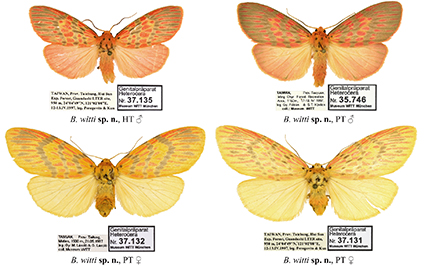Abstract
Meris paradoxa Rindge, thought to be restricted to southeastern Arizona, is documented in Mexico for the first time. Previously described only from males, we provide the first description of the female from specimens collected as caterpillars and reared to adults. We find female M. paradoxa to have a normal haustellum; an external diagnostic character for this species previously only confirmed in conspecific males. Female genitalia of M. paradoxa are found similar to other Meris, but the absence of a sclerotized signum (present in congeners) may prove autapomorphic. Natural history information for the genus is discussed in light of new data reported here for Mexican M. paradoxa.
References
- Boros, C.A., Stermitz, F.R. & McFarland, N. (1991) Processing of iridoid glycoside antirrinoside from Maurandya antirrhiniflora (Scrophulariaceae) by Meris paradoxa (Geometridae) and Lepipolys species (Noctuidae). Journal of Chemical Ecology, 17, 1123–1133. https://doi.org/10.1007/BF01402938 DOI: https://doi.org/10.1007/BF01402938
- Brehm, G., Murillo-Ramos, L., Sihvonen, P., Hausmann, A., Schmidt, B.C., Õunap, E., Moser, A., Mörtter, R., Bolt, D., Bodner, F., Lindt, A., Parra, L.E. & Wahlberg, N. (2019) New world geometrid moths (Lepidoptera: Geometridae): Molecular phylogeny, biogeography, taxonomic updates and description of 11 new tribes. Arthropod Systematics and Phylogeny, 77 (3), 457–486.
- Garzón-Orduña, I.J. (2021) Description of female Nemeris mexicola Dyar (Geometridae: Ennominae). Journal of the Lepidopterists’ Society, 75, 187–190.
- Goloboff, P. & Catalano, S. (2016) TNT version 1.5, including a full implementation of phylogenetic morphometrics. Cladistics, 32, 221–238. https://doi.org/10.1111/cla.12160 DOI: https://doi.org/10.1111/cla.12160
- Kearse, M., Moir, R., Wilson, A., Stones-Havas, S., Cheung, M., Sturrock, S., Buxton, S., Cooper, A., Markowitz, S., Duran, C., Thierer, T., Ashton, B., Mentjies, P. & Drummond, A. (2012) Geneious Basic: an integrated and extendable desktop software platform for the organization and analysis of sequence data. Bioinformatics, 28, 1647–1649. https://doi.org/10.1093/bioinformatics/bts199 DOI: https://doi.org/10.1093/bioinformatics/bts199
- Kristensen, N.P. (2003) Handbook of Zoology. Vol. IV. Arthropoda: Insecta. Part 36. Lepidoptera, Moths and Butterflies. Vol. 2. Morphology, Physiology, and Development. De Gruyter, Berlin-New York, New York, xii + 564 pp.
- Lafontaine, J.D. (2004) The Moths of America North of Mexico. Fascicle 27.1. Noctuoidea, Noctuidae (part): Noctuinae, Agrotini. The Wedge Entomological Research Foundation, Washington, D.C., 385 pp.
- Morrone, J.J. (2020) The Mexican Transition Zone: A natural biogeographic laboratory to study biotic assembly. Springer Nature Switzerland AG, Cham, XII + 191 pp. https://doi.org/10.1007/978-3-030-47917-6 DOI: https://doi.org/10.1007/978-3-030-47917-6
- Murillo-Ramos, L., Chazot, N., Sihvonen, P., Õunap, E., Jiang, N., Han, H., Clarke, J.T., Davis, R.B., Tammaru, T. & Wahlberg, N. (2021) Molecular phylogeny, classification, biogeography and diversification patterns of a diverse group of moths (Geometridae: Boarmiini). Molecular Phylogenetics and Evolution, 162, 107198. https://doi.org/10.1016/j.ympev.2021.107198 DOI: https://doi.org/10.1016/j.ympev.2021.107198
- Pitkin, L.M. (2002) Neotropical ennominae moths: a review of the genera (Lepidoptera: Geometridae). Zoological Journal of the Linnean Society, 135, 121–401. https://doi.org/10.1046/j.1096-3642.2002.00012.x DOI: https://doi.org/10.1046/j.1096-3642.2002.01200.x
- Poole, R.W. (1970) Convergent evolution in the larvae of two Penstemon–feeding geometrids (Lepidoptera: Geometridae). Journal of the Kansas Entomological Society, 43 (3), 292–297.
- Rindge, F.H. (1981) A revision of the moth genera Meris and Nemeris (Lepidoptera, Geometridae). American Museum Novitates, No. 2710, 1–28.
- Rindge, F.H. (1985) A revision of the moth genus Acronyctodes, with a review of the new Bistonini (Lepidoptera, Geometridae). American Museum Novitates, No. 2807, pp. 1–24.
- Scoble, M.J. (1999) Geometrid moths of the world, a catalogue. CSIRO Publishing, Apollo Books, Collingwood and Stenstrup, 1400 pp. https://doi.org/10.1071/9780643101050 DOI: https://doi.org/10.1071/9780643101050
- Stermitz, F.R., Gardner, D.R. & McFarland, N. (1988) Iridoid glycoside sequestration by two aposematic Penstemon-feeding geometrid larvae. Journal of Chemical Ecology, 14 (2), 435–441. https://doi.org/10.1007/BF01013895 DOI: https://doi.org/10.1007/BF01013895
- Swofford, D.L. (2002) PAUP*. Phylogenetic Analysis Using Parsimony (*and Other Methods). Version 4. Sinauer Associates, Sunderland, Massachusetts. [program]
- Vázquez, L. (1936) Contribución al conocimiento del los lepidópteros mexicanos III. El genero Synopsia en los “Tepozanes” del centro de Mexico (Lepidoptera: Geometridae). Anales de Instituto de Biología UNAM, 7, 65–75, figs. 1–7.
- Wagner, D.L., Ferguson, D.C., McCabe, T.L. & Reardon, R.C. (2002) Geometroid caterpillars of northeastern and Appalachian forests. USFS Technology Transfer Bulletin, FHTET-2001-10, 1–239. https://doi.org/10.5962/bhl.title.150204 DOI: https://doi.org/10.5962/bhl.title.150204
- Wahlberg N. & Wheat C.W. (2008) Genomic outposts serve the phylogenomic pioneers: designing novel nuclear markers for genomic DNA extractions of Lepidoptera. Systematic Biology, 57, 231–242. https://doi.org/10.1080/10635150802033006 DOI: https://doi.org/10.1080/10635150802033006


